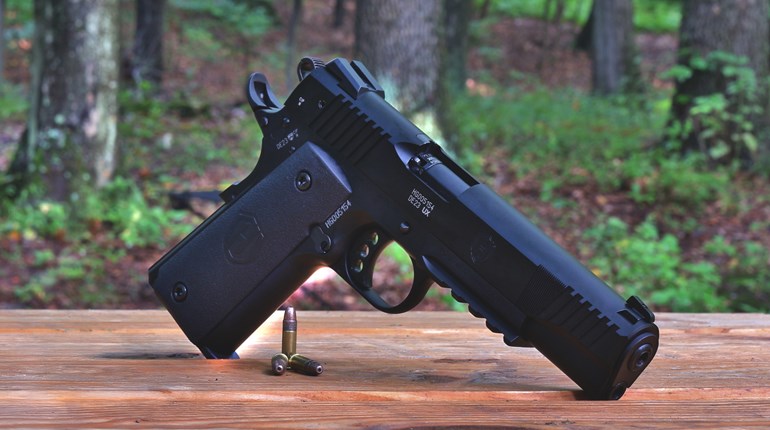
SilencerCo’s Switchback 22 is one of the more interesting suppressors, made with modularity that offers not only a choice of three different lengths, but also the ability to augment sound reduction on arms with barrels longer than 10.5 inches by changing the baffle direction. The Switchback is rated for all .22- and .17-caliber rimfires, .22 Hornet and 5.7x28 mm. Dimensionally, this suppressor is 1.07 inches in diameter with a weight of 3.2 to 6.5 ounces and overall length of 2.5 to 5.75 inches.
Robustly made for the long term, this suppressor eschews aluminum in favor of more durable materials: grade-9 titanium tube, 17- 4 stainless steel end cap and mount and heat-treated, hardened baffles milled from 17-4 bar stock. Given those materials, it’s no surprise that there are no minimum barrel lengths and a full-auto rating for .22 LR.
The back cap is the serial numbered part, which allows SilencerCo to replace a damaged tube without having to remanufacture the suppressor. This saves you a $200 transfer tax and a whole lot of wait time compared to suppressors that have the serial number on the tube itself, should the device need repair.
The Switchback offers four possible configurations that screw together using two spanner wrenches included with the unit: Short, Medium, Long-Default and Long-Rifle-Optimized. The latter offers a modicum of additional sound reduction. In its long configuration, the sections are ordered as follows from rear to front: Back Cap-Short Tube-Coupler-Long Tube-Front Cap. The Long-Default and Long-Rifle Optimized configurations are both full length but orient the four baffles in the Long Tube differently. In the Default setting, these baffles point backward toward the firearm’s muzzle and are consistent with the direction of the other baffles. In the Rifle Optimized setting, these baffles point downrange. The improvement in sound reduction only applies to barrels longer than 10.5 inches. Used on shorter barrels, accuracy and sound reduction will suffer compared to the Default setting.

The Switchback uses vented-cone-type baffles that snap together tightly to prevent combustion gasses and vaporized lead from bonding the baffles to the inner walls of the tube—which would make disassembly difficult—without applying excess force that could damage the suppressor. For best sound reduction and accuracy, baffles should be stacked with their vents aligned. Witness dots on the outside of the baffles facilitate the correct placement.
I tested the Switchback to ascertain the answers to three questions: How effective is this can in reducing sound? What additional sound reduction comes from using the Optimized setting? Is there any change in bullet point-of-impact and accuracy when attached to a Tikka T1x bolt-action rifle and a Ruger MK IV pistol?
The Switchback was tested in its Optimized configuration against two of the most effective and comparably sized suppressors made: the Advanced Armament Corporation Halcyon and the SIG Sauer SRD-22X. I used the Tikka T1x as the host and conducted the test on the same afternoon in the same weather conditions, the same lot of CCI Standard Velocity ammo and identical sound-meter placement.
Results showed that the sound reduction of all three cans was nearly identical, with the highest and lowest average reading over 10 shots being only .70 dB apart. The Switchback scored in the middle, measuring just .46 dB louder than the Halcyon and just .24 dB quieter than SRD-22X. The results were so close the differences may not be statistically significant and could be caused by minor differences in the powder charge of the ammo, and such differences are imperceptible to the human ear. Mounted onto the Ruger MK IV pistol, there was no first-round pop using standard-velocity ammo and only an occasional instance when using high velocity.
These sound readings show the Switchback is quite effective in reducing noise, but how much more effective is the Optimized configuration compared to the Default? Very little as it turned out, with the average additional sound reduction from two, 10-shot strings measuring only .58 dB and .24 dB. These differences are imperceptible, but a tone-sensitive observer can detect a change of pitch between the two settings.
A suppressor’s primary purpose is to reduce noise, but they can create side effects, two of which are a shift in the bullet’s point-of-impact on the target and a change in accuracy. The effects vary by host firearm, and a suppressor can improve or diminish its accuracy. The Tikka T1x used in this test is probably the most accurate .22 LR you can find in its price range. It delivered five, 50-yard groups of five shots which averaged a mere .325 inch using CCI Standard Velocity ammo and a Caldwell Precision Turret Rest.
With the Switchback attached in its Long-Default configuration, the group widened to .757 inch with a couple unexplained fliers expanding a smaller three- to four-shot cluster. That’s still a tighter group than many rifles deliver without using a suppressor, which alters the barrel harmonics. The point-of-impact shifted 1 inch downward, a factor that was repeated after removing and reattaching the unit, so you can dial in a repeatable correction to your scope when attaching the Switchback rather than re-zeroing it every time it’s used. Mounted onto the Ruger MK IV pistol and shot at 20 yards, however, the Switchback had no perceptible effect on group size or bullet impact point.
The Switchback is a high-quality build that is easy to clean, offers flexibility to reconfigure its length to suit a user’s preferences and is made with long-lasting materials. The design is well thought out, even in minor details such as including a barrel spacer to properly mount the unit on a barrel with threads .600 to .650 inch in length and having wrench flats on each section to ease disassembly. Perhaps most importantly, the Switchback lives up to SilencerCo’s claim of delivering top-tier noise reduction.





































